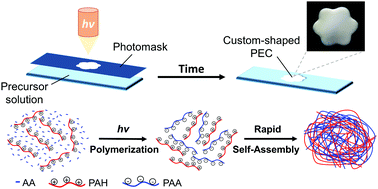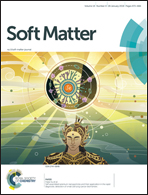Customizing polyelectrolyte complex shapes through photolithographic directed assembly†
Abstract
Polyelectrolyte complexes (PECs) form through the association of oppositely charged polymers and, due to their attractive properties, such as their mild/simple preparation and stimulus-sensitivity, attract widespread interest. The diverse applications of these materials often require control over PEC shapes. As a versatile approach to achieving such control, we report a new photolithographic directed assembly method for tailoring their structure. This method uses aqueous solutions of a polyelectrolyte, an oppositely charged monomer and a photoinitiator. Irradiation of these mixtures leads to site-specific polymerization of the ionic monomer into a polymer and, through this localized polyanion/polycation mixture formation, results in the assembly of PECs with 2-D and 3-D shapes that reflect the photoirradiation pattern. In addition to generating macroscopic PECs using photomasks, this photodirected PEC assembly method can be combined with multiphoton lithography, which enables the preparation of custom-shaped PECs with microscopic dimensions. Like other PECs, the custom-shaped structures formed through this photodirected assembly approach are stimulus-responsive, and can be made to switch shape or dissolve in response to changes in their external environments. This control over PEC shape and stimulus-sensitivity suggests the photopolymerization-based directed PEC assembly method as a potentially attractive route to stimulus-responsive soft device fabrication (e.g., preparation of intricately shaped, function-specific PECs through photolithographic 3-D printing).



 Please wait while we load your content...
Please wait while we load your content...